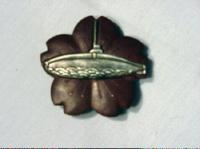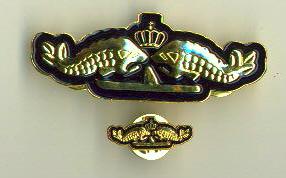|
JAPAN- The United States sold Japan five Holland submarines in 1905. In 1906, Kawasaki built Holland boats under contract. During World War II, the Imperial Fleet had a large submarine force, but it was used in tactical situations vice strategic situations. This meant that the threat was minimal as compared to the German U-Boat fleet. The Japanese Submarine Force was dismantled at the end of the war. The Maritime Defense Force in Japan reestablished the submarine fleet in 1954 with Guppy submarines from the Untied States. At this time the Japanese fleet consists of 18 submarines, six Harushio Class, ten Yuushio Class and two Uzushio Class. The first submarine badge was for enlisted personnel who had graduated from submarine training. It was a Holland boat appliqued on a brown cherry blossom. Prior to World War II, these badges were collected for security and no badge was worn during the war. The current badge has two dolphins facing a blossom on top of an anchor. It appears that there is a bow-on submarine under the anchor flukes. This badge is referred to as the "short badge due to its size. The gold version is for officer and the silver version is for enlisted personnel. Miniature versions are available. The badges have horizontal safety pin attachment but clutch pin attachments have been seen. |



|
LATIVA- No badge is known for Lativa. The Lativa Navy did use two French built submarines after their commissioning in 1937. Other then that little is known about Lativa and the fate of their submarines. |
|
LIBYA- Around 1967, Libya used Soviet Navy personnel for training of their sub fleet. The current Libyan Submarine Fleet is 4 ex-Soviet Foxtrot Class (Al Badr Class) submarines. I don't have a picture of the Libyan Submarine Badge, but apparently this badge is very hard to find due to embargoes on Libya. |
|
NETHERLANDS- The Netherlands entered the submarine arena with the commissioning of the Luctor et Energo, which was based on Electric Boat plans in 1906. The Netherland Navy purchased other boats from other foreign companies until 1914 when they decided to design two class of submarines. The O Class was a coaostal boat and the K Class was a long range submarine. After 1936 all subs were designated as "O". Dutch boats did participate in World War II. In 1960, the Dutch created the Zwaardis Class which had the claim to fame of being the most efficient submarine of the 1970s. At this time, the Dutch Submarine Force consist of four improved Zwaardis Class submarines. The badge has two bottle-nosed dolphins with their tail crossed and supporting an Albacore type submarine. This badge was authorized in 1965. It is worn by all submarine members, officer and enlisted personnel. The badge is a clutch pin attachment. The miniature version is not for mess dress but for personnel that are submarine trainees. |

|
NORTH KOREA- North Korea operates four Whiskey Class and twenty Romeo Class submarines. They are operate the midget for commando operations. North Korea does not have a submarine bade at this time. However, I have heard rumors that the badge to the right is the design of the new badge they are coming up with for submarine personnel. |

|
NORWAY- Germany sold the Norwegian Navy its first submarine in 1908. It was basically designed like the U-1 submarine. The A-3 Class submarines were bought from Germany also from 1911 to 1912. The B Class which was design from Electric Boats designs was designated in 1915 but it was not delivered until 1929. At the beginning of World War II in 1940, Norway wsa forced to scuttle and abandon six submarines to prevent the invading Germans from capturing them. During the war, Norwegian Navy used three British submarines. Three more British subs were added to the Norwegian Submarine Fleet after the war, increasing the fleet to five (one of the earlier subs was sunk in 1943). These five served in the active ranks until the middle of the 1960s . In the 1950s, Norway ordered five modified German 205 Class subs.and redesignated them as the Koben Class. A total of nine were eventually bought and three were sold to Denmark. At this time, the Norwegian Submarine Force consists of six improved Koben Class and six Ula Class submarines. The Norwegian Submarine Badge was authorized in 1957 and was similiar to a medal. It is now used as a qualification badge. The badge has two "cod" over a submarine silhouette. The Royal crown is a top the "cod". The gold badge is worn by all ranks who are qualified in submarines. The copper badge is for a submariner in training. A silver version is floating around, but it's not an offical badge. The other badge that is shown is also an unauthorized badge. It is a gold badge with a black edging. A miniature is available. |



| Home Page |